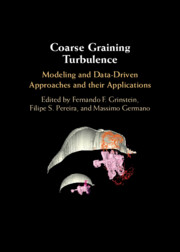Book contents
- Frontmatter
- Contents
- Contributors
- Prologue
- Part I Paradigms and Tools
- Part II Challenges
- 9 Transition to Turbulence
- 10 Wall-Bounded Turbulence
- 11 Scale-by-Scale Nonequilibrium in Turbulent Flows
- 12 Coarse-Graining in Multiphase Flows: From Micro to Meso to Macroscale for Euler–Lagrange and Euler–Euler Simulations
- 13 Coarse Graining for Thermal Flows
- 14 High-Order Simulations of Supersonic Combustion
- 15 Coarse-Graining Supersonic Combustion
- 16 Transition and Multiphysics in Inertial Confinement Fusion Capsules
- 17 Firestorms, Fallout, and Atmospheric Turbulence Induced by a Nuclear Detonation
- Epilogue
- Abbreviations
- Index
- References
9 - Transition to Turbulence
from Part II - Challenges
Published online by Cambridge University Press: 31 January 2025
- Frontmatter
- Contents
- Contributors
- Prologue
- Part I Paradigms and Tools
- Part II Challenges
- 9 Transition to Turbulence
- 10 Wall-Bounded Turbulence
- 11 Scale-by-Scale Nonequilibrium in Turbulent Flows
- 12 Coarse-Graining in Multiphase Flows: From Micro to Meso to Macroscale for Euler–Lagrange and Euler–Euler Simulations
- 13 Coarse Graining for Thermal Flows
- 14 High-Order Simulations of Supersonic Combustion
- 15 Coarse-Graining Supersonic Combustion
- 16 Transition and Multiphysics in Inertial Confinement Fusion Capsules
- 17 Firestorms, Fallout, and Atmospheric Turbulence Induced by a Nuclear Detonation
- Epilogue
- Abbreviations
- Index
- References
Summary
Most turbulence theory is derived in a theorized asymptotic state. But real engineering problems almost never reach such a state; in the real world, the route to turbulence leaves its fingerprints on the observed flow. Any coarse-grained simulation must handle this, either by resolving the transition process or modeling some or all of it. Either approach faces significant challenges. If the transition is to be resolved, then a suitable mechanism for turning on and off any turbulence model in the appropriate places is needed. If it is to be modeled, then the model must be capable of handling subfilter fluctuations that may have very different properties than those of fully developed turbulence. All of these approaches have been tried in the literature, and a complete solution is still an active research problem. This chapter reviews the approaches that have been used for coarse-grained simulation of transition.
- Type
- Chapter
- Information
- Coarse Graining TurbulenceModeling and Data-Driven Approaches and their Applications, pp. 263 - 305Publisher: Cambridge University PressPrint publication year: 2025

